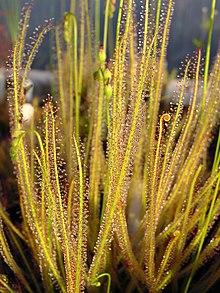Drosera filiformis
 From Wikipedia - Reading time: 6 min
From Wikipedia - Reading time: 6 min
| Thread-leaved sundew | |
|---|---|

| |
| Scientific classification | |
| Kingdom: | Plantae |
| Clade: | Tracheophytes |
| Clade: | Angiosperms |
| Clade: | Eudicots |
| Order: | Caryophyllales |
| Family: | Droseraceae |
| Genus: | Drosera |
| Subgenus: | Drosera subg. Drosera |
| Section: | Drosera sect. Drosera |
| Species: | D. filiformis
|
| Binomial name | |
| Drosera filiformis Raf. (1808)
| |
| Synonyms | |
| |
Drosera filiformis, commonly known as the thread-leaved sundew,[2] is a small, insectivorous, rosette-forming species of perennial herb. A species of sundew, it is unusual within its genus in that the long, erect, filiform (thread-like)[2] leaves of this plant unroll in spirals – an arrangement similar to the circinate vernation seen in ferns.
Distribution and habitat
[edit]D. filiformis occurs naturally in both Canada and the United States; its natural range extends down the eastern seaboard of North America from south western Nova Scotia[2] in the north down through New England to Florida in the south. Its disjunct distribution on the Atlantic Coast reflects the prehistoric land connection between Nova Scotia and Cape Cod, Massachusetts, which formed an ancient extension of the Atlantic Plain region that likely persisted well into the current interglacial period as an island chain.[2]: 4 D. fliformis is also found on the Gulf Coast from Florida to Louisiana, although the Gulf Coast population may represent Drosera tracyi.[2]: 3
Cultivation
[edit]D. filiformis is frequently cultivated, with a few registered cultivars, such as D. filiformis var. filiformis (also known as D. filiformis typical), D. filiformis × 'California Sunset' (a hybrid between D. filiformis var. filiformis.) All of these cultivars are grown with similar conditions as most other Drosera species: mineral-poor soil and distilled, reverse osmosis, or collected rain water. D. filiformis require a winter dormancy for long-term survival, forming hibernacula in the winter.
Conservation
[edit]D. filiformis is a Schedule 1–listed endangered species of Canada under the Species at Risk Act.[3] It is considered range-wide to be of "least concern" according to the International Union for Conservation of Nature. Threats include development, peat mining and competition from shrubs.[1]
Infraspecific taxa
[edit]- Drosera filiformis f. tracyi (Macf. ex Diels) Macf. (1914)
- Drosera filiformis var. tracyi (Macf. ex Diels) Diels (1906)
- Drosera filiformis var. typica Winne (1944) nom.illeg.

References
[edit]- ^ a b Smith, K. (2016). "Drosera filiformis". IUCN Red List of Threatened Species. 2016: e.T64311210A67694064. doi:10.2305/IUCN.UK.2016-1.RLTS.T64311210A67694064.en. Retrieved 9 November 2023.
- ^ a b c d e B. Freedman; J. Jotham (2001). "Update COSEWIC status report on the thread-leaved sundew Drosera filiformis in Canada, in COSEWIC assessment and update status report on the thread-leaved sundew Drosera filiformis in Canada" (PDF). Ottawa: Committee on the Status of Endangered Wildlife in Canada. Retrieved 9 November 2023.
- ^ "Thread-leaved Sundew (Drosera filiformis)". Species at risk public registry. Government of Canada. 13 June 2023. Retrieved 9 November 2023.
 KSF
KSF